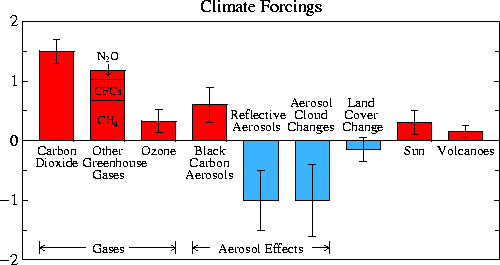Has anyone actually explained exactly WHY and HOW an ice-free Arctic is such a disaster? And for whom would it be a disaster? And in what way it would be a disaster? --Kevin Cave
In part one, I wrote about the loss of biodiversity in the Arctic, and the consequences of that for humans. Another, potentially even more destructive consequence of the loss of the Arctic sea ice is the amplification of global warming via changes in albedo -- the amount of solar energy which is reflected back by the earth's surface. A surface that reflected everything -- like a perfect mirror -- would have an albedo of zero. A "blackbody" that absorbed all the radiation that hit it would have an albedo of one.
Sea ice reflects 70% of the solar energy that hits it. Open water reflects only 8%. Consequently, the replacement of sea ice by open water means more global warming. It's a positive feedback. But is it enough heat to worry about?
Things that push the climate system towards warming or cooling are called forcings, and are measured in units of watts per square meter (W * m^2). The table below shows recent estimates of climate forcings:

You can see that the CO2 forcing is about 1.5W*m^2. How does the loss of sea ice compare?
First, a few simplifications, since your author is not especially adept at math. Mr. Cave ask about an ice-free Arctic, so we are going to look at the total disappearance of the ice. In reality, there will be sea ice in the winter for the forseeable future. There is very little incoming solar radiation during the "six months of night" (read=none) and so we can more or less ignore any winter ice.
We are also going to ignore clouds, which can push the absorption of the surface up or down. While open water absorbs about 92% of the solar energy coming from directly overhead, radiation from a more oblique angle is reflected much more readily. The calculations of albedo vs latitude vs the position of the sun are complex, but in midsummer the sun is more or less directly overhead. So to estimate this effect, I'm going to have the forcing. Remember, we are not trying to answer the question of what exactly the impact of the loss of sea ice will be, but rather Mr. Cave's "Why should I care?" question. For that, rough estimates should work.
The National Snow and Ice Data Center has a nice description of the incoming solar radiation in the Arctic:
The intensity of solar radiation varies significantly over the course of a year ranging from no solar radiation during the polar winter to a maximum of 350 to 400 watts per square meter (W/m2) in the summer. Over the course of a day, the sun's angle above the horizon (solar altitude) influences the intensity of solar radiation: the noon sun is more intense than the rising or setting sun. The maximum altitude of the sun depends on time of year and latitude. Of course, during the polar winter the sun is below the horizon for 24 hours, and there is no solar radiation, while at midsummer the sun changes little in altitude over the course of a day.
Now we have enough numbers to conjure with:
Surface area of the Earth: 510,072,000 km2
Summer Arctic ice cover: 7,500,000 km2 (estimate)
Summer Arctic ice cover as a % of the Earth's surface: 1.5%
Summer solar radiation: 300W/m2 (estimated summer average compared to 350-400 max)
Now we need a conversion of the change in energy absorbed in the Arctic, in the summer, to the equivalent forcing over the whole Earth, all year round:
300W/m2 * .3 = 90W/m2 (sea ice)
300W/m2 * .92 = 276W/m2 (open water)
Change in absorption = (276 - 90) = 186W/m2
186W/m2 * 1.5% (.015) * 0.5 (summer -- half the year) * 0.5 (angle of incidence fudge factor) = 0.7W/m2 (vs 1.5W/m2 for all the CO2 added the the atmosphere by man since 1750).
Even with a frankly embarrassingly simplified back-of-the-envelope calculation, we can see that the loss of Arctic sea ice will accelerate global warming significantly. Along with the loss of biodiversity, these are two very significant reasons to be concerned by the loss of the Arctic ice cover. I'll look at a third reason, the local effects on methane deposits and land-bound Greenland ice, in part three.
There's a chance you are qualified for a new solar rebate program.
ReplyDeleteClick here to discover if you are eligble now!